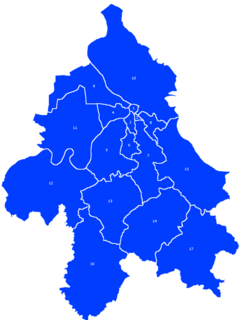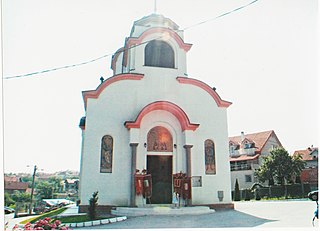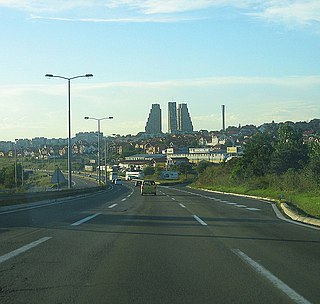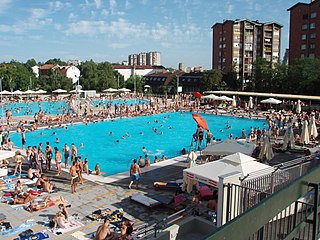
Kaluđerica is an urban neighborhood of Belgrade, Serbia. It is located in the municipality of Grocka.
This article deals with the system of transport in Belgrade, both public and private.

Voždovac is a municipality of the city of Belgrade. According to the 2011 census results, the municipality has a population of 158,213 inhabitants.

Zvezdara is a municipality of the city of Belgrade. The municipality is geographically hilly and with many forests. According to the 2011 census results, the municipality has a population of 148,014 inhabitants.

Singidunum was an ancient city which later evolved into modern Belgrade, the capital of Serbia. The name is of Celtic origin, going back to the time when Celtic tribe Scordisci settled the area in the 3rd century BC, following the Gallic invasion of the Balkans. Later on, the Roman Republic conquered the area in 75 BC and incorporated it into the province of Moesia. It was an important fort of the Danubian Limes and Roman Legio IV Flavia Felix was garrisoned there since 86 AD. Singidunum was the birthplace to the Roman Emperor Jovian. It was sacked by Huns in 441, and by Avars and Slavs in 584. At the beginning of the 7th century, the Singidunum fort was finally destroyed.

Grocka or Grocka na Dunavu is a municipality of the city of Belgrade. According to the 2011 census results, the municipality has 83,906 inhabitants.

Čukarica is a municipality of the city of Belgrade.

Dušanovac, is an urban neighbourhood of Belgrade, the capital of Serbia. It is located in the municipality of Voždovac.

Bulevar kralja Aleksandra is the longest street entirely within the urban limits of Serbian capital Belgrade, with length of 7.5 kilometers. Known for decades after World War II as Bulevar Revolucije, it is so distinct in the Belgraders' hearts and minds that they simply refer to it as the Bulevar, although there are 20 boulevards in Belgrade.

The city of Belgrade is divided into 17 municipalities.

The Mokroluški Creek is a stream in north-central Serbia, which forms a 15-kilometre-long (9 mi) former right tributary to the Sava river. During its entire course, it runs through the urban section of Belgrade. It is one of the 40 rivers, streams and creeks that flow or used to flow through Belgrade, but the majority of them are conducted underground into the city sewage system which is also the case with Mokroluški potok.

Veliki Mokri Lug is an urban neighbourhood of Belgrade, Serbia. It is located in Belgrade's municipality of Zvezdara.

Kumodraž is an urban neighborhood of Belgrade, Serbia. It is located in Belgrade's municipality of Voždovac.

Padina is an urban neighborhood of Belgrade, the capital of Serbia. It is located in Belgrade's municipality of Zvezdara. After one of the central streets, it is also called Vojvoda Vlahović, but is also referred to as Braće Jerković II, because it makes urban connection to it. The neighborhood is sometimes also referred to as Medaković Padina.

Stepin Lug or Gaj is a park-forest and, for the most part, non-residential suburban settlement of Belgrade, the capital of Serbia. It is located in Belgrade's municipalities of Voždovac and Zvezdara. It is part of the forest complex Stepin Lug-Baba Velka-Torlak-Jajinci, which is the largest wooden area in Belgrade.
Cvetkova Pijaca or colloquially Cvetko is an open green market and an urban neighborhood of Belgrade, the capital of Serbia. It is located in Belgrade's municipality of Zvezdara.

Stari Đeram, colloquially Đeram, is an open greenmarket and an urban neighborhood of Belgrade, the capital of Serbia. It is located in Belgrade's municipality of Zvezdara.

Konjarnik is an urban neighborhood of Belgrade, the capital of Serbia. It is divided between Belgrade's municipalities of Voždovac and Zvezdara. As a large neighborhood, it has several sub-neighborhoods of its own, including Denkova Bašta, Učiteljsko Naselje and Rudo.

Zeleno Brdo is an urban neighborhood of Belgrade, the capital of Serbia. It is located in Belgrade's municipality of Zvezdara.

Mirijevo is an urban neighborhood of Belgrade, Serbia. It is located in Belgrade's municipality of Zvezdara. One of the largest single neighborhoods in Europe, consists of several sub-neighborhoods














